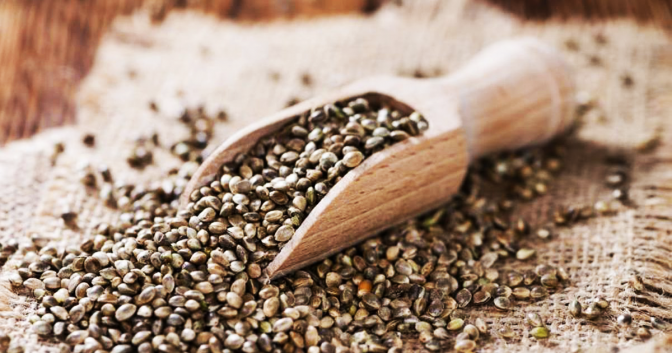What You Need to Know About Hemp Food Products

For millennia, hemp seeds—the byproduct of the plant cultivated for fiber—have been used in food products. Hemp seeds and hemp oil are a great source of nutrition, and hemp food possibly offers therapeutic benefits when used in food production.
Somewhere between 40,000 and 100,000 metric tons of hemp are produced worldwide each year, with China being the largest producer of hemp seeds. Botanically, hemp seeds are small nuts. They’re rounder and thicker then sunflower seeds. Husks can be removed by processing, and the seeds are used in a variety of products, such as protein powders and bars. The nutmeat contains about 45% fat and 35% protein; the remaining 20% represents carbohydrates, sugar, ash and moisture content. There are about twice as many carbohydrates in unhulled hemp seeds, versus just the nutmeat.
A lot of interest has focused lately on the use of hemp seeds for their oil, and their use in nutritional products. Most of the analytical data available about hemp seeds focuses on essential fatty acid content. This composition of fatty acids is largely influenced by the specific variety, cultivar or genetics. Recent research on hemp suggests several things:
Some professional athletes in weight-restriction sports use hemp protein powder. (MMA fighters like Ronda Rousey and Kyle Kingsbury have discussed the role of hemp protein in their regimens). One reason is because hemp protein increases nutritional absorption. In 2015, the Carpathian Journal of Food Science & Technology published a study examining the effect of hemp food consumed in the morning and evening. After three weeks, the group receiving hemp protein had significantly higher levels of hemoglobin, serum protein and prealbumin.
Genetics primarily determine oil content, while environmental factors primarily determine the antioxidant and fatty acid profiles. A 2004 article in Euphytica investigated the nutritional content of seeds from 51 varieties of cannabis in 11 countries. “The oil content of hemp seeds may be increased by classical breeding methods, but the antioxidants and fatty acids seem to depend even more on environmental factors than the oil content does,” the authors wrote.
Hemp oil doesn’t form trans-fatty acids when cooked. A 1999 article in the Journal of the International Hemp Association compared the effect of cooking temperatures (175C–250C) on trans-fatty acid formation in hemp cooking oil. Contrary to popular belief, hemp cooking oil does not form trans-fatty acids under normal cooking temperatures. The authors speculated that this is due to the high vitamin E content of the oil.
THC and other cannabinoids are not present in hemp seeds, but trace amounts of cannabinoids can find their way into hemp seed products accidentally during processing, such as when seeds are separated from the flowers, which produce the cannabinoids. Federal and international regulations prohibit cannabis resin, such as THC, from being contained in hemp products by setting strict limits (see deadiversion.usdoj.gov for more info)
Dust at hemp processing plants contains many valuable substances, such as rare fatty acids and cannabidiol (CBD), the American Chemical Society determined in 2015. These waste products could be processed, salvaging numerous compounds for use in research.
Hemp proteins contain a high amount of the amino acid arginine (94–128 mg/g protein) compared to other food proteins, such as whole wheat (48 mg/g protein). Arginine serves as a dietary precursor for the formation of nitric oxide (NO), a potent mediator of the vascular system and thus important for heart health. Additionally, no production has been linked to optimal immune function and muscle repair. The Journal of Agricultural and Food Chemistry published a study in 2010 that recommended hemp protein as a dietary source of arginine.
Hemp seeds and their hulled nut-meats are established as important ingredients in the natural foods market. However, formulating hemp seeds into a protein bar or fancy treat is difficult, and scientists are still working to solve some of the stability, storage and shipping issues.
This year, researchers in Canada, at the University of Manitoba, published their work on an industrially scalable method that uses food-grade enzymes to digest most of the polysaccharides in a defatted low-protein hemp seed meal— allowing greater stability and flexibility in formulating hemp products. Hemp seeds and oil offer balanced nutrition, savory taste and great versatility as raw materials. As farming hemp becomes more common and technologies improve, hemp will become an even more valuable food source in the future.
If you enjoyed this Freedom Leaf article, subscribe to the magazine today!

